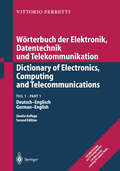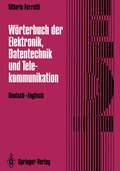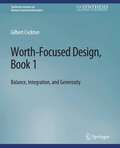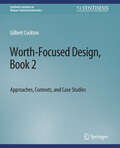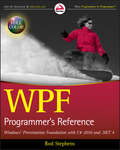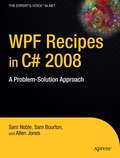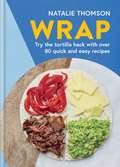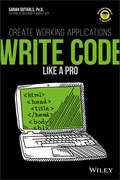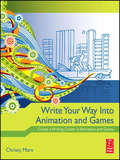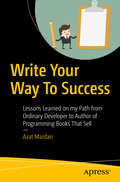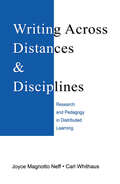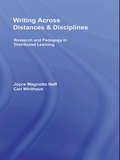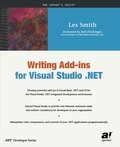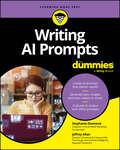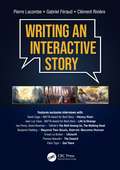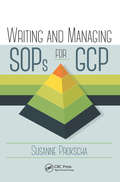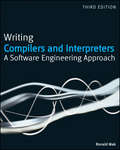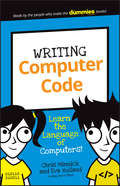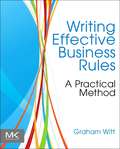- Table View
- List View
Wörterbuch der Elektronik, Datentechnik und Telekommunikation / Dictionary of Electronics, Computing and Telecommunications: Teil 1: Deutsch-Englisch / Part 1: German-English
by Vittorio FerrettiSeit Erscheinen der 1. Auflage sind vor allem im Konvergenzbereich der Datentechnik und Telekommunikation neue Techniken entstanden und damit auch eine Vielzahl neuer Fachausdrücke. Die Durchdringung der Telekommunikationstechnik mit Datentechniken hat zugenommen. Um dem gerecht zu werden, wurde diese 2. Auflage erheblich erweitert: mit 159.000 Begriffen steht hiermit ein ausführlicher Wegweiser zur Verfügung, um sich im Gewirr der deutschen und englischen Fachtermini zurechtzufinden. Das lexikalische Konzept (Nennung des Fachgebiets für jeden Eintrag, Zusatzinformationen wie Kurzdefinitionen, Synonyme, Quasisynonyme, Gegensatzwörter, Ober- und Unterbegriffe) sowie das tabellarische Layout wurden beibehalten und eine Maximierung der Übersetzungssicherheit und des Bedienungskomforts erreicht.
Wörterbuch der Elektronik, Datentechnik und Telekommunikation / Dictionary of Electronics, Computing and Telecommunications: Deutsch-Englisch / German-English
by Vittorio FerrettiWorth-Focused Design, Book 1: Balance, Integration, and Generosity (Synthesis Lectures on Human-Centered Informatics)
by Gilbert CocktonDesign now has many meanings. For some, it is the creation of value. For others, it is the conception and creation of artefacts. For still others it is fitting things to people. These differences reflect disciplinary values that both overlap and diverge. All involve artefacts: we always design things. Each definition considers people and purpose in some way. Each handles evaluation differently, measuring against aesthetics, craft standards, specifications, sales, usage experiences, or usage outcomes. There are both merits and risks in these differences, without an appropriate balance. Poor balance can result from professions claiming the centre of design for their discipline, marginalising others. Process can also cause imbalance when allocating resources to scheduled stages. Balance is promoted by replacing power centres with power sharing, and divisive processes with integrative progressions. A focus on worth guides design towards worthwhile experiences and outcomes that generously exceed expectations. This book places a worth focus (Wo-Fo) in the context of design progressions that are Balanced, Integrated, and Generous (BIG). BIG and Wo-Fo are symbiotic. Worth provides a focus for generosity. Effective Wo-Fo needs BIG practices.
Worth-Focused Design, Book 2: Approaches, Context, and Case Studies (Synthesis Lectures on Human-Centered Informatics)
by Gilbert CocktonThis book introduces the concept of worth for design teams, relates it to experiences and outcomes, and describes how to focus on worth when researching and expressing design opportunities for generous worth. Truly interdisciplinary teams also need an appropriate common language, which was developed in the companion book Worth-Focused Design, Book 1: Balance, Integration, and Generosity (Cockton, 2020a). Its new lexicon for design progressions enables a framework for design and evaluation that works well with a worth focus. Design now has different meanings based upon the approach of different disciplinary practices. For some, it is the creation of value. For others, it is the conception and creation of artefacts. For still others, it is fitting things to people (beneficiaries). While each of these design foci has merits, there are risks in not having an appropriate balance across professions that claim the centre of design for their discipline and marginalise others. Generosity is key to the best creative design—delivering unexpected worth beyond documented needs, wants, or pain points. Truly interdisciplinary design must also balance and integrate approaches across several communities of practice, which is made easier by common ground. Worth provides a productive focus for this common ground and is symbiotic with balanced, integrated, and generous (BIG) practices. Practices associated with balance and integration for worth-focused generosity are illustrated in several case studies that have used approaches in this book, complementing them with additional practices.
WPF Programmer's Reference: Windows Presentation Foundation with C# 2010 and .NET 4
by Rod StephensBuild effective user interfaces with Windows Presentation Foundation Windows Presentation Foundation (WPF) is included with the Windows operating system and provides a programming model for building applications that provide a clear separation between the UI and business logic. Written by a leading expert on Microsoft graphics programming, this richly illustrated book provides an introduction to WPF development and explains fundamental WPF concepts. Packed with helpful examples, this reference progresses through a range of topics that gradually increase in their complexity. You’ll quickly start building applications while you learn how to use both Expression Blend and Visual Studio to build UIs. In addition, the book addresses the needs of programmer who write the code behind the UI and shows you how operations can be performed using both XAML and C#. Topics Covered: Overview of WPF WPF in Visual Studio Expression Blend Common Properties Content Controls Layout Controls User Interaction Controls Two-Dimensional Drawing Controls Properties Pens and Brushes Events and Code-Behind Resources Styles and Property Triggers Event Triggers and Animation Templates Themes and Skins Printing Data Binding Commanding Transformations and Effects Documents Navigation-Based Applications Three-Dimensional Drawing Silverlight Even if you only have a minimal amount of experience, by the end of the book, you will be able to build dynamic and responsive user interfaces with WPF.
WPF Programmer's Reference: Windows Presentation Foundation with C# 2010 and .NET 4
by Rod StephensBuild effective user interfaces with Windows Presentation Foundation Windows Presentation Foundation (WPF) is included with the Windows operating system and provides a programming model for building applications that provide a clear separation between the UI and business logic. Written by a leading expert on Microsoft graphics programming, this richly illustrated book provides an introduction to WPF development and explains fundamental WPF concepts. Packed with helpful examples, this reference progresses through a range of topics that gradually increase in their complexity. You’ll quickly start building applications while you learn how to use both Expression Blend and Visual Studio to build UIs. In addition, the book addresses the needs of programmer who write the code behind the UI and shows you how operations can be performed using both XAML and C#. Topics Covered: Overview of WPF WPF in Visual Studio Expression Blend Common Properties Content Controls Layout Controls User Interaction Controls Two-Dimensional Drawing Controls Properties Pens and Brushes Events and Code-Behind Resources Styles and Property Triggers Event Triggers and Animation Templates Themes and Skins Printing Data Binding Commanding Transformations and Effects Documents Navigation-Based Applications Three-Dimensional Drawing Silverlight Even if you only have a minimal amount of experience, by the end of the book, you will be able to build dynamic and responsive user interfaces with WPF.
WPF Recipes in C# 2008: A Problem-Solution Approach
by Sam Bourton Allen Jones Sam NobleWindows Professional Foundation (WPF) offers amazing opportunities to .NET programmers in terms of the user interfaces they can deliver to their customers. But this significant technological advance comes with a steep learning curve, requiring the programmer to learn new classes, new syntax, and an entirely new approach to user interface development. Although WPF has been generally available since 2008, commercial take–up has been relatively slow, and the publicly available body of knowledge has been weak in terms of real–world examples and best–practice information. Using WPF Recipes in C# 2008, you'll find a simple and straightforward approach to solving the problems you face every day. Each solution contains a complete, working example that demonstrates how to make the best use of WPF. You can use the example as a template to solve your own problem or as a base on which to build a solution tailored to your specific needs. Packed with well–structured and documented solutions to a broad range of common WPF problems, this book, will be a valuable addition to any C# programmer's reference library. Examples included provide you with a rich source of information as you begin to learn and will be an invaluable quick–reference guide once you're a proficient WPF programmer. The emphasis on solving the day–to–day WPF problems that all programmers face frees you from needing to trawl through weighty programming tomes or sift through API documentation, allowing you to focus on the more interesting and innovative aspects of your project.
Wrap: Try the tortilla hack with over 80 quick and easy recipes
by Natalie ThomsonOriginating on TikTok and quickly going viral across the rest of social media, the 'wrap hack' or '4-way wrap' involves taking a tortilla wrap and using a clever quartering technique to divide the wrap into four, placing a different filling in each section and folding into a quick and delicious meal. Suitable for leftovers, breakfasts, lunches, quick snacks and sweet treats - this genius foodie hack will not only lift you out of a sandwich rut, but will also get your creative juices flowing as you try out new flavour combinations with your friends.Wrap brings together over 80 recipes for the ingenious method all in one place. Hot, cold, meat or veggie: whatever you put into your wrap, this method is the viral sensation that has to be tried.CONTENTSChapter 1: Breakfast & BrunchIncluding Smoked salmon, Tofu scramble and Sausage hashChapter 2: Quick Light BitesIncluding Shredded duck, Spicy fish goujons and Korean blue cheeseChapter 3: Hunger FixesIncluding Veggie burrito, Pulled jackfruit and Philly cheese steakChapter 4: Something SweetIncluding Banana, caramel & chocolate, Eton mess and Apple & blackberry crumble
Write Code Like a Pro: Create Working Applications
by GuthalsCODERS ARE ROCK STARS Coders are the people who are building the future. You can stake your own claim on the future by learning pro coding techniques. Take a look inside to figure out how and why coders think a bit differently, the basics of building a working application with a professional coding language, and how to test your app to make sure it works. Get a jump on your future as a rock-star coder today! See the big picture – get a grip on how pro coders start and finish a project Know the code – get your hands on a pro coding language and put it to work Make things happen – create a working application you can share with friends
Write Code Like a Pro: Create Working Applications
by Sarah GuthalsCODERS ARE ROCK STARS Coders are the people who are building the future. You can stake your own claim on the future by learning pro coding techniques. Take a look inside to figure out how and why coders think a bit differently, the basics of building a working application with a professional coding language, and how to test your app to make sure it works. Get a jump on your future as a rock-star coder today! See the big picture – get a grip on how pro coders start and finish a project Know the code – get your hands on a pro coding language and put it to work Make things happen – create a working application you can share with friends
Write Your Way into Animation and Games: Create a Writing Career in Animation and Games
by Christy MarxLaunch your career in writing for video games or animation with the best tips, tricks, and tutorials from the Focal press catalog--all at your fingertips. Let our award-winning writers and game developers show you how to generate ideas and create compelling storylines, concepts, and narratives for your next project. Write Your Way Into Animation and Games provides invaluable information on getting into the game and animation industries. You will benefit from decades of insider experience about the fields of animation and games, with an emphasis on what you really need to know to start working as a writer. Navigate the business aspects, gain unique skills, and develop the craft of writing specifically for aniamtion and games. Learn from the cream of the crop who have shared their knowledge and experience in these key Focal Press guides: Digital Storytelling, Second Edition by Carolyn Handler Miller Animation Writing and Development by Jean Ann Wright Writing for Animation, Comics, and Games by Christy Marx Story and Simulations for Serious Games by Nick Iuppa and Terry Borst Writing for Multimedia and the Web, Third Edition by Timothy Garrand
Write Your Way into Animation and Games: Create a Writing Career in Animation and Games
by Christy MarxLaunch your career in writing for video games or animation with the best tips, tricks, and tutorials from the Focal press catalog--all at your fingertips. Let our award-winning writers and game developers show you how to generate ideas and create compelling storylines, concepts, and narratives for your next project. Write Your Way Into Animation and Games provides invaluable information on getting into the game and animation industries. You will benefit from decades of insider experience about the fields of animation and games, with an emphasis on what you really need to know to start working as a writer. Navigate the business aspects, gain unique skills, and develop the craft of writing specifically for aniamtion and games. Learn from the cream of the crop who have shared their knowledge and experience in these key Focal Press guides: Digital Storytelling, Second Edition by Carolyn Handler Miller Animation Writing and Development by Jean Ann Wright Writing for Animation, Comics, and Games by Christy Marx Story and Simulations for Serious Games by Nick Iuppa and Terry Borst Writing for Multimedia and the Web, Third Edition by Timothy Garrand
Write Your Way To Success: Lessons Learned On My Path From Ordinary Developer To Writer Of Multiple Programming Books That Sell
by Azat MardanLearn how to make an impact in the web world. This short book shows you that the best way to become an expert and a thought leader is to thoroughly research a topic and then publish a book on it. The great thing about writing a book is that you don’t have to risk anything - all you need is a few hours of writing per week and in no time you can have your own book that you can sell, give away at conferences, and prominently feature on your resume. Since author Azat Mardan published his first book, several high profile tech companies have tried to recruit him and his experience is not an exception! Write Your Way To Success covers everything that he has learned through publishing – see how you can do the same!What You'll LearnCreate passive incomeReview the process of a ProgWriterExamine practical tips about publishing and marketingWho This Book Is ForAny experts (or wannabe experts) in technical topics, tools, frameworks for web development, applied computer science, dev ops and QA.
Writing Across Distances and Disciplines: Research and Pedagogy in Distributed Learning
by Joyce Magnotto Neff Carl WhithausWriting Across Distances and Disciplines addresses questions that cross borders between onsite, hybrid, and distributed learning environments, between higher education and the workplace, and between distance education and composition pedagogy. This groundbreaking volume raises critical issues, clarifies key terms, reviews history and theory, analyzes current research, reconsiders pedagogy, explores specific applications of WAC and WID in distributed environments, and considers what business and education might teach one another about writing and learning. Exploring the intersection of writing across the curriculum, composition studies, and distance learning , it provides an in-depth look at issues of importance to students, faculty, and administrators regarding the technological future of writing and learning in higher education.
Writing Across Distances and Disciplines: Research and Pedagogy in Distributed Learning
by Joyce Magnotto Neff Carl WhithausWriting Across Distances and Disciplines addresses questions that cross borders between onsite, hybrid, and distributed learning environments, between higher education and the workplace, and between distance education and composition pedagogy. This groundbreaking volume raises critical issues, clarifies key terms, reviews history and theory, analyzes current research, reconsiders pedagogy, explores specific applications of WAC and WID in distributed environments, and considers what business and education might teach one another about writing and learning. Exploring the intersection of writing across the curriculum, composition studies, and distance learning , it provides an in-depth look at issues of importance to students, faculty, and administrators regarding the technological future of writing and learning in higher education.
Writing Add-ins for Visual Studio .NET
by Les SmithThis book is designed to teach add-in development using Visual Studio.NET to the novice as well as the experienced developer, with real code examples to demonstrate how.
Writing AI Prompts For Dummies
by Stephanie Diamond Jeffrey AllanLearn the art of writing effective AI prompts and break into an exciting new career field Writing AI Prompts For Dummies gets you started on the path toward becoming an “AI psychologist” capable of getting all types of output from AI systems. This book walks you through the process of mining great results from leading platforms, so you can save time, solve problems, explore creative ideas, conduct research, and beyond. Even if you’re brand new to using AI chatbots, you’ll be able to follow the jargon-free explanations and instructions inside to learn how to ask questions and make requests in terms any AI can understand. Then, you can convert your new skill into greater productivity in your life, or even into a new career. Prompt engineering is a fast-growing career opportunity with six-figure salaries attached. Who knows? This Dummies guide could be your launchpad to a future as an AI whisperer. Explore the top AI chatbots, creativity engines, and productivity tools Learn how to write basic text prompts that generate concise, effective output Create AI-generated photos and illustrations that match your vision Save time writing code, designing websites, or conducting research When asked “Who needs to learn prompt engineering?” ChatGPT clarifies: professionals, creatives, educators, scientists, and entrepreneurs in many fields can benefit an enhanced ability to use AI productively. And for anyone working in AI, natural language processing, or related areas, Writing AI Prompts For Dummies is simply a must.
Writing AI Prompts For Dummies
by Stephanie Diamond Jeffrey AllanLearn the art of writing effective AI prompts and break into an exciting new career field Unlock the full power of generative AI with Writing AI Prompts For Dummies, a comprehensive guide that will teach you how to confidentially write effective AI prompts. Whether it's text, images, or even videos and music you're aiming to create, this book provides the foundational knowledge and practical strategies needed to produce impressive results. Embark on a journey of discovery with Writing AI Prompts For Dummies and learn how to: Craft AI prompts that produce the most powerful results. Navigate the complexities of different AI platforms with ease. Generate a diverse range of content, from compelling narratives to stunning visuals. Refine AI-generated output to perfection and integrate that output effectively into your business or project. This resource is brimming with expert guidance and will help you write AI prompts that achieve your objectives. Whether you're a marketer, educator, artist, or entrepreneur, Writing AI Prompts For Dummies is your indispensable guide for leveraging AI to its fullest potential. Get ready to harness the power of artificial intelligence and spark a revolution in your creative and professional efforts.
Writing an Interactive Story
by Pierre Lacombe Gabriel Feraud Clement RiviereVideo games have become the world's largest leading cultural product. Though disputed in the past, the narrative qualities of video games have finally secured distinction in the realm of art. This is especially true for interactive games. Writing an Interactive Story will help the reader in navigating the creation process of interactive scripts, in addition to discovering behind the scenes narrative choices of renowned games, and will help you to harness your inner creativity. Guided by master interactive scriptwriters, the text presents its content in the form of a unique writing workshop. With interactive game writing, the player becomes the star of the work. Thanks to this method of storytelling, the morals of the game become resonant. This is because the weight of the narrative’s choices and consequences rest fully upon the player. It's the ultimate narrative. Whether you are a video game enthusiast, student, or professional, discover how to create a more immersive personalized experience than ever before and give your players the opportunity to write their own destiny through their choices. The methods, strategies, and secrets of this new art await you. Features exclusive interviews with: David Cage – BAFTA Award for Best Story – Heavy Rain Jean-Luc Cano - BAFTA Award for Best Story – Life Is Strange Joe Penny, David Bowman – Telltale’s The Wolf Among Us, The Walking Dead Benjamin Diebling – Beyond Two Souls, Detroit: Become Human Erwan Le Breton – Ubisoft Thomas Veauclin– The Council Fibre Tigre – Out There
Writing an Interactive Story
by Pierre Lacombe Gabriel Feraud Clement RiviereVideo games have become the world's largest leading cultural product. Though disputed in the past, the narrative qualities of video games have finally secured distinction in the realm of art. This is especially true for interactive games. Writing an Interactive Story will help the reader in navigating the creation process of interactive scripts, in addition to discovering behind the scenes narrative choices of renowned games, and will help you to harness your inner creativity. Guided by master interactive scriptwriters, the text presents its content in the form of a unique writing workshop. With interactive game writing, the player becomes the star of the work. Thanks to this method of storytelling, the morals of the game become resonant. This is because the weight of the narrative’s choices and consequences rest fully upon the player. It's the ultimate narrative. Whether you are a video game enthusiast, student, or professional, discover how to create a more immersive personalized experience than ever before and give your players the opportunity to write their own destiny through their choices. The methods, strategies, and secrets of this new art await you. Features exclusive interviews with: David Cage – BAFTA Award for Best Story – Heavy Rain Jean-Luc Cano - BAFTA Award for Best Story – Life Is Strange Joe Penny, David Bowman – Telltale’s The Wolf Among Us, The Walking Dead Benjamin Diebling – Beyond Two Souls, Detroit: Become Human Erwan Le Breton – Ubisoft Thomas Veauclin– The Council Fibre Tigre – Out There
Writing and Managing SOPs for GCP
by Susanne ProkschaWriting and Managing SOPs for GCP is the first book to discuss managing Standard Operating Procedures (SOPs) for Good Clinical Practice (GCP) from conception to retirement. It recommends approaches that have a direct impact on improving SOP and regulatory compliance. Throughout the text, the book provides a user's point of view to keep topics focus
Writing Compilers and Interpreters: A Software Engineering Approach
by Ronald MakLong-awaited revision to a unique guide that covers both compilers and interpreters Revised, updated, and now focusing on Java instead of C++, this long-awaited, latest edition of this popular book teaches programmers and software engineering students how to write compilers and interpreters using Java. You?ll write compilers and interpreters as case studies, generating general assembly code for a Java Virtual Machine that takes advantage of the Java Collections Framework to shorten and simplify the code. In addition, coverage includes Java Collections Framework, UML modeling, object-oriented programming with design patterns, working with XML intermediate code, and more.
Writing Computer Code: Learn the Language of Computers! (Dummies Junior)
by Chris Minnick Eva HollandA technology book for kids! Learning how to code can be like learning a foreign language.This book serves as an excellent guide to help you start writing in the odd-looking languages that make the web work. Follow simple steps as you work with real code to build your own web robots. Create your robot—write code that builds your robot's body and structure Give your bot some style—add code lines that customize your robot's color and shape Get your robot moving—finish off your robot with code that teaches it how to dance Technology Requirements: Hardware – PC or tablet with Internet connection running Windows 7 or higher or Mac with Internet connection running Mac OS X 10.7 or higher Software – Web browser to access JSFiddle.net: Google Chrome™, Mozilla Firefox, Apple Safari, Microsoft Edge, or Microsoft Internet Explorer version 9.0 or higher
Writing Computer Code: Learn the Language of Computers! (Dummies Junior)
by Chris Minnick Eva HollandA technology book for kids! Learning how to code can be like learning a foreign language.This book serves as an excellent guide to help you start writing in the odd-looking languages that make the web work. Follow simple steps as you work with real code to build your own web robots. Create your robot—write code that builds your robot's body and structure Give your bot some style—add code lines that customize your robot's color and shape Get your robot moving—finish off your robot with code that teaches it how to dance Technology Requirements: Hardware – PC or tablet with Internet connection running Windows 7 or higher or Mac with Internet connection running Mac OS X 10.7 or higher Software – Web browser to access JSFiddle.net: Google Chrome™, Mozilla Firefox, Apple Safari, Microsoft Edge, or Microsoft Internet Explorer version 9.0 or higher
Writing Effective Business Rules
by Graham WittWriting Effective Business Rules moves beyond the fundamental dilemma of system design: defining business rules either in natural language, intelligible but often ambiguous, or program code (or rule engine instructions), unambiguous but unintelligible to stakeholders. Designed to meet the needs of business analysts, this book provides an exhaustive analysis of rule types and a set of syntactic templates from which unambiguous natural language rule statements of each type can be generated. A user guide to the SBVR specification, it explains how to develop an appropriate business vocabulary and generate quality rule statements using the appropriate templates and terms from the vocabulary. The resulting rule statements can be reviewed by business stakeholders for relevance and correctness, providing for a high level of confidence in their successful implementation.A complete set of standard templates for rule statements and their component syntactic elementsA rigorous approach to rule statement construction to avoid ambiguity and ensure consistencyA clear explanation of the way in which a fact model provides and constrains the rule statement vocabularyA practical reader-friendly user guide to the those parts of the SBVR specification that are relevant to rule authoring
